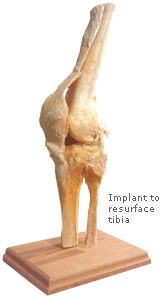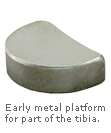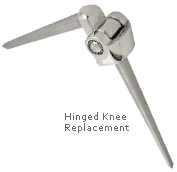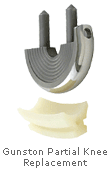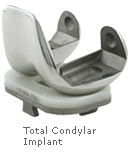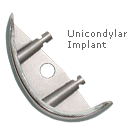Designing a Knee
Designing a Knee
The knee is in some ways a more complex joint than the hip.
It has three parts: the bottom of the femur, the top of the tibia, and the patella or kneecap, which covers the front of the joint.
The femur rests directly on the tibia, like one platform sitting on another - the bones are not actually "joined". The femur is held in place entirely by tendons and ligaments, so preserving them during knee surgery is important. A cushion of cartilage, which can be damaged or destroyed by arthritis, prevents the bones from rubbing directly on each other.
We tend to think of the knee as "swinging like a gate", but its motion is actually more complex, with some side to side and circular movement possible as well.
An Early Knee Implant
In the 1930s, surgeons began to experiment with resurfacing one part of knee joint - either the tibia or femur.
This metal platform was used to provide a new surface for part of the tibia. It was developed by David MacIntosh in Toronto about 1960.
Hinged Knee Replacement
The first total knee replacements were designed to work like a hinge.
This design, however, is quite different from the structure of the original knee and does not replicate the knee's motion well. As a result of the strains and stresses put on the bond, this type of knee implant tended to loosen with use.
Breakthrough in Materials
This implant, designed by Canadian Frank Gunston in 1968, was the first to use a cobalt-chromium alloy "runner" rocking on a high-density polyethylene platform.
These materials are still the standard for knee implants, although the design itself was quickly superseded by sturdier models.
Total Condylar Implant
This replacement, developed in the early 1970s, was a major leap forward in the design of knee implants. This design replicates the motion of the knee very well and provides new surfaces for all parts of the joints.
It has become the basis for all modern knee replacements.
Unicondylar Implant
When a person has arthritis in only one part of the knee, and the rest of it remains healthy, it is now possible to receive a unicondylar implant.
This replaces only the damaged part, and leaves the rest of the knee intact. There is a faster recovery time and less scarring.
| Look at early designs for hip replacements |
| View more modern hip replacements |

